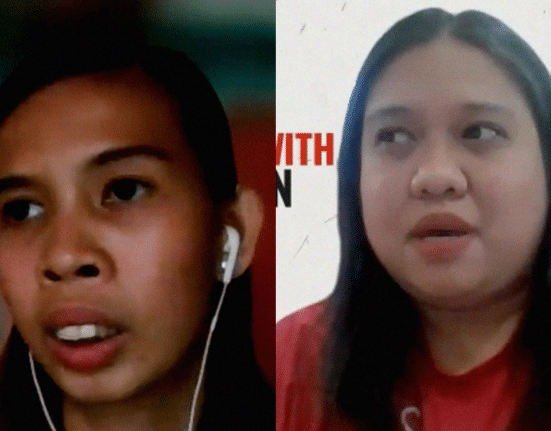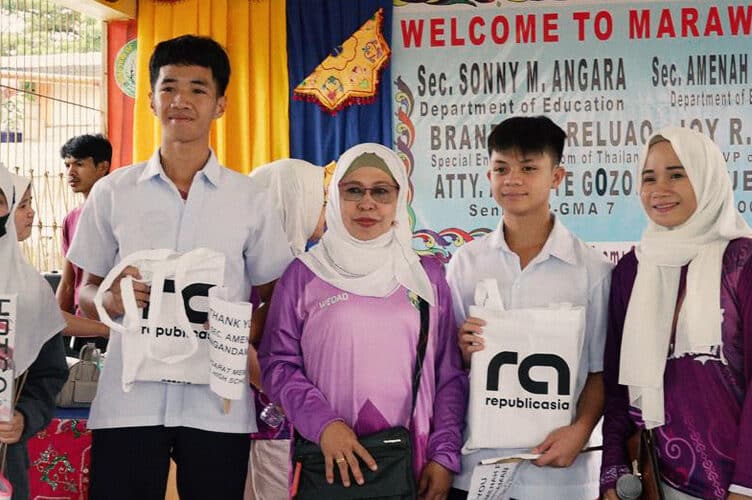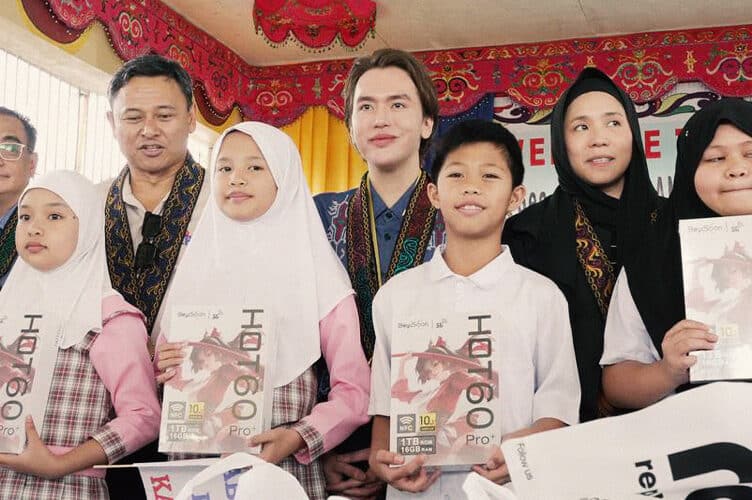APRIL Correa, 33, is the current project coordinator for Safer Kids Philippines, a branch of the non-profit organization Save the Children, made to help protect children from issues like online sexual abuse and exploitation – which they simply refer to by the term OSAEC.
Speaking to republicasia, Correa recounts one of the most harrowing cases she’s heard of to be that of a young boy rescued by child protection service providers, happening before she even came to be a part of Safer Kids. His mother had been reported to the authorities after she had been discovered fondling her son’s private parts as per the instructions of a customer she met online, lifting him toward a web camera for the stranger to see.
Why did she need to lift him up? Because he couldn’t yet stand on his own. He was only three to four months old when all of this was going on, Correa had said.
She explained that these perpetrators – these pedophiles – find satisfaction in seeing children getting sexually abused. And looking for a means to make money, the parents of these children (or sometimes even the children themselves) seek out these customers willing to pay whatever amount to satisfy their carnal desires.
It doesn’t matter if it’s a stranger, or friends, or family members, or even your parents. In the face of online sexual exploitation, ties no longer matter.
More specifically: in the face of money, morals no longer matter.
A much-needed introduction
At present, the Philippines has been labeled the world’s number one source for content that features the online sexual exploitation of children.
A 2022 study called Disrupting Harm in the Philippines highlighted the growing problem of OSAEC in the Philippines. This study interviewed 950 children aged 12 to 17 years and found that 20 percent of them were victims of OSAEC in one way or another. Their involvement ranged from being blackmailed into doing sexual activities online, having their intimate photos spread around, or selling their photos and videos as a means to earn money and gifts from their customers.
The most commonly used platforms for these transactions according to these children were Facebook or Facebook Messenger as well as TikTok, Twitter, Snapchat, and Instagram. Often the common perpetrators that look for content are people from other countries. And in situations wherein the children do not make the decision to sell content themselves and are forced into it, it’s often friends or family members that coerce them into doing so.
Of the children interviewed by Disrupting Harm authors, many felt that they could not report what had happened for various reasons.
Some were afraid of being judged, while others felt they lacked evidence to find justice for themselves. But what was truly sad was that there were others who thought what happened was normal.
The study also states that there are at least two million children within the country that are subjected to the horrifying phenomena of OSAEC each day; any child with access to the internet and a curious mind immediately becomes a target.
While it is hard to pinpoint all the possible causes of OSAEC, the Salinlahi Alliance for Children’s Concerns pointed to poverty as one of the primary reasons.
The poverty rate in the Philippines as of March 2023 is at 13.2 percent.
Safer Kids aims to help strengthen child protection systems by working with the government, schools, communities, service providers, as well as local law enforcers to help children in the poorest sectors of the Philippines, assisting children that are not only victims of OSAEC but those in need of protection in general. The group has been working in the Philippines for over 40 years, first established back in 1981, and has managed to help around 560, 000 children thus far.
Meanwhile, Salinlahi has been around in the Philippines since 1986, first starting as the Salinlahi Foundation and then later on becoming a member organization of GABRIELA, the National Alliance of Women in the Philippines. Similar to the Safer Kids group, Salinlahi is a campaign center that pushes for the creation of laws and policies aimed to protect children from issues like OSAEC in the Philippines.
Groups like Salinlahi and Safer Kids continue to fight for the issues of these children to be heard, demanding for the government and the masses to take action, and demanding for justice to be given where it is due.
But they can only do so much to control the situation when it seems like all odds are against them; as explained by Norielyn Lariosa, the 26-year-old Officer in Charge at Salinlahi.
The role of non-government organizations stops at guiding those in the government to actually do their jobs.
Lariosa was quick to say that it is the government that the people should hold most accountable in the fight against OSAEC.
if no all-around approach is applied, then it will only continue to worsen.
A growing problem
Given that the internet has only been with us for a few decades, Correa has labeled OSAEC to be a fairly new phenomenon, which started to catch the attention of people come 2013 to 2014. This is why Safer Kids was born as Save the Children’s first-ever effort to fight back against OSAEC.
Correa recounts how before she started working for Save the Children, she would often encounter cases of abused, exploited children back in another job where she worked in Cebu. She would see how in 2013, children started to find more ways to earn money given the slow, steady rise of the internet’s popularity.
She explained: “Dati, they go to internet shops na may cover lang na kurtina, and then they go to dating apps, they go to Yahoo messenger, doon sila kumakausap ng kung sinu-sino kasi diba if you remember… kung saan-saang rooms ka pwede pumasok, so you can chat with strangers.”
“So yun yung naging simula and then they started earning money from it. They transitioned from being exploited on the streets— meaning nasa streets sila at nag-aantay ng tinatawag nilang parokyano or customers – they transitioned from there to online, or pinagsasabay nila.”
And because the internet was starting to become accessible to everyone, it became more difficult for child protection organizations to keep track of new cases. It is especially more difficult when it’s the children themselves entering into these situations with the thought that there’s nothing wrong with whatever they may be doing.
And now, with the onslaught of the pandemic, everybody has a laptop, desktop, tablet, or cellphone at home. This means that anybody and everybody can be a victim of OSAEC, no matter their class or social standing.
Though Yahoo Messenger may have faded away, this problem hasn’t. It only switched platforms, with some of the most prevalently used being Facebook Messenger, Twitter, Viber, Telegram, and Skype.
In the realm of Twitter, for example, alter accounts have become all the rage. If you type in the word “alter” on the sites, one word that’s quick to follow is ‘bagets’ – translating in English to someone who’s an adolescent, a teen, or sometimes even a tween. Basically: someone young.
Correa states that many children use this avenue as a means to exchange photos and videos with one another, as well as to sell content. The first time she heard of the phenomenon was in 2019.
Several users in the Twitterverse state that they are of legal age but their photos and videos do not seem to hold up to that statement.
Correa said the problem persists because no matter how many times you may report an account or a tweet, the sheer number of them makes everything hard to monitor.
“Ang dami dami nila over the internet, so it’s really hard to take down all of them at once,” she said.
Both Salinlahi and Safer Kids agreed that in the rising number of OSAEC cases in the Philippines, the internet is one of the biggest contributors to its spread.
No more middleman
In republicasia’s interview with Lariosa, she stated that in the past, people would use money-changing services like Palawan Express or Lhuillier to send money to one another. Before, there was no need to explain your relation to the sender or the receiver. This changed as laws became stricter.
At present, it is harder to send money anonymously through e-wallets like PayMaya, GCash, and PayPal.
Lariosa explains that these are one of the new developments in the realm of OSAEC that have made it all the more difficult to track these cases down.
She said: “Sa pagpapadaa naman sa GCash, wala ka naman kailangang i-ano diyan, basta i-send lang… yung PayPal, ganun din.”
It is harder to track these transactions given that the capabilities of the Philippines’ technology are nothing like those in other countries. Potential cases can be tracked but classifying them as OSAEC will take some time.
Salinlahi calls for local authorities to enhance the country’s capabilities to combat OSAEC. Often, in dealing with cases of online abuse, the Philippines has to ask for help from other countries in order to get more detailed information
Combined with the ease of lying about information online, transactions for child sexual abuse materials (CSAM) can be done with just a few taps.
A slow justice system
Lariosa said that as a campaign center, Salinlahi doesn’t often deal with cases directly. They did assist, however, in the case of a 13-year-old girl named Alyanna* in 2020.
Due to the need for a device for class amid the sudden onslaught of the pandemic, Alyanna looked online for ways she could get enough money to buy one because, at the time, she and her family were struggling with money.
Both her parents were out of work. Her father was in jail. She felt she had no other option. So she turned to Facebook, where she met Jack. At the time of his first message to her, he was 31.
The two started talking to one another. Jack started making promises toward Alyanna, saying that he would be able to help her out of her predicament. Eventually, Alyanna agreed to meet with Jack.
In exchange for a cell phone, Jack raped her.
Alyanna and her family followed all the right steps afterward to seek justice for what had happened to her: she filed a report, she took the case to court, she and the rest of Salinlahi and their partner organizations tried their best to have Jack rightfully rot in jail for all that he did to her.
But months passed. And then years. But no progress had been made.
Lariosa said it could have had something to do with the fact that Jack had a lot of money, while Alyanna was poor.
Even while in court, Alyanna already felt little hope that she was going to get the justice she deserved. Lariosa states that during the first hearing, the child faced harsh victim-blaming from the people at the hearing.
In the end, Alyanna and her family got tired of waiting, deciding to instead take an P 80,000 settlement money which was given to her in installments. This amount was to ensure that Jack would be able to walk away from the whole situation scott-free with absolutely no criminal record.
Lariosa recalled: “Yung gusto nga ni victim, tapusin na natin dahil nakakapagod na rin naman daw na mag-push pa pero wala din namang nangyayari, at ang tagal din naman.”
He spent only three months in jail during the time of this entire case and today walks the earth as a free man. Meanwhile, Alyanna spent those two years going through interventions, consultations, and therapy just so she could move on from what had happened.
Move on, perhaps, but never forget.
“Right now, si [Alyanna] ay hindi na nag-aaral,” Lariosa shared. There was a hint of sadness in her tone – perhaps even defeat.
“Parang nawalan na rin ng gana mag-aral, at [nag]trabaho nalang.”
Lariosa explained that at present, Alyanna has slowly started to heal from her experiences. But when it comes to victims of OSAEC – or any act of sexual violence – fully being able to heal from what you’ve experienced is seldom guaranteed. Often they are still bothered months or even years after what has happened to them; anything, big or small, can be a trigger.
Trust issues
Victims of OSAEC commonly develop a sense of distrust toward men. And without proper intervention, many of them do not know how to properly process whatever they’ve experienced. Slowly afterward, mental health issues like depression and PTSD are quick to follow.
Coping with trauma is a long process, requiring a strong support system from family, friends, organizations, as well as medical professionals. The bruises may fade but the mental and emotional scars take much longer to disappear entirely.
What needs to be done
In Alyanna’s case, no justice was served. That is a reality for thousands of Filipino children each day the number of OSAEC grows. And while the Philippines does have laws that help to safeguard children, such as the Anti-OSAEC Law or Republic Act 11930, many organizations feel that there is still much to be done.
Both Salinlahi and Safer Kids, for example, call upon internet service providers (ISPs) to prevent the proliferation of OSAEC in the Philippines. Correa calls upon them to do their part in the active blocking of these forms of content wherever people may have access to it.
Furthermore, these organizations also call upon companies like Meta that own these social media websites used to proliferate such materials, firmly stating that the guidelines for signing up and scrolling said sites are much too lenient, allowing practically anyone to lie about their age and make an account in less than ten minutes.
Social media websites should thus be stricter in their age requirements to ensure that if a child is below the age requirement, there is no way they will be able to make an account and be exposed to these forms of content, as well as to people who may seek these materials out.
Included in the responsibilities of these websites is also to raise awareness of OSAEC as well as the issues surrounding it to aid children in the safe usage of social media.
“Sila yung mga malalaking mga company na mayroong capacity na mag-inform sa mga tao dahil lahat ng mga tao ay gumagamit ng mga ganito,” explained Lariosa.
“So sila yung may capacity na magbigay ng information dissemination paano ligtas na gagamitin yung mga social media app, at sila din yung may hawak [sa kung] paano mawawala yung ganitong materials na hindi na makikita ng mga bata.”
And aside from those that provide Filipinos with access to such content, accountability must also be taken by the government in keeping these children safe. They must do better to hold ISPs and social media websites accountable for their actions because they are the ones with the capacity to control and monitor these cases.
More programs and services must also be passed, according to Lariosa, catering to the prevention of OSAEC as well as to helping those that have fallen victim to it in the country. The establishment and development of a comprehensive, coordinated national response within the online world is something only the government can do since they’re the ones with the manpower and equipment to deal with such problems.
If anything, Lariosa agrees that the response of the government toward OSAEC so far has been lacking; for something considered to be a national problem, nobody seems to be treating it as such.
* The names of the victims and perpetrators in this story have been changed for privacy purposes.
How useful was this post?
Click on a star to rate it!
Average rating 0 / 5. Vote count: 0
No votes so far! Be the first to rate this post.
We are sorry that this post was not useful for you!
Let us improve this post!
Tell us how we can improve this post?







